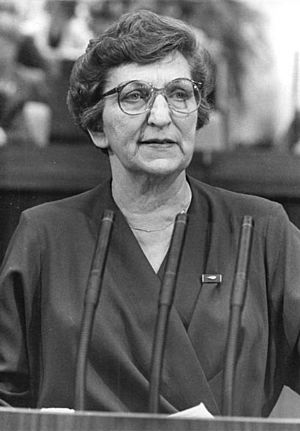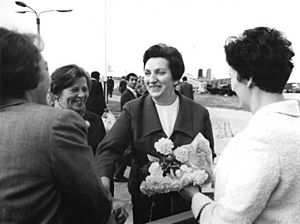Ilse Thiele facts for kids
Quick facts for kids
Ilse Thiele
|
|
|---|---|

Thiele in 1987
|
|
| Chairwoman of the Democratic Women's League of Germany | |
| In office September 1953 – November 1989 |
|
| Preceded by | Elli Schmidt |
| Succeeded by | Eva Rohmann |
| Member of the Volkskammer | |
| In office 1954 – March 1990 |
|
| Member of the State Council | |
| In office 1971 – January 1990 |
|
| Personal details | |
| Born |
Ilse Neukrantz
4 November 1920 Berlin, Germany |
| Died | 10 January 2010 (aged 89) Berlin, Germany |
| Political party |
|
| Spouse | Heinz Thiele (1913–2002) |
| Children | 3 |
| Occupation | Politician |
Ilse Thiele (born November 4, 1920 – died January 10, 2010) was an important politician in East Germany. She was a key member of the SED party, which was the main ruling party. She served on its powerful Central Committee from 1954 to 1989.
Ilse Thiele also led the national Democratic Women's League (DFD). She was the Chair of this organization from 1953 until 1989. This group focused on women's issues and was a big part of public life in East Germany.
Contents
Her Life and Political Journey
Growing Up in Berlin
Ilse Neukrantz was born in Berlin, in a part of the city called Lichtenberg. Her father worked in a warehouse and later did office jobs. Her mother was a milliner, which means she made and sold hats.
Ilse and her brother, Heinz, went to school in their local area. From 1937 to 1945, she worked as a stenographer. A stenographer is someone who writes down what people say very quickly, often using shorthand.
Joining Politics After the War
World War II ended in May 1945. This also meant the end of Nazi Germany and its one-party rule. Ilse Thiele, who was a housewife living near Celle, decided to join the Communist Party.
By 1946, she moved to the part of Germany controlled by the Soviet Union. Here, the Communist Party joined with another party, the Social Democratic Party. They formed a new party called the Socialist Unity Party of Germany (SED). Ilse Thiele quickly became a member of this new, powerful party.
She continued working as a stenographer for a while. In 1946, she also joined the Trade Unions Federation. From 1948 to 1950, she was a local councilor in Berlin-Lichtenberg. This meant she helped manage social issues in her community. She was also part of the SED party leadership in Lichtenberg.
In 1950, she became the Berlin leader for the Democratic Women's League (DFD). This group was very important for women in East Germany. She also studied at the Karl Marx Party Academy in 1950 and 1951.
Leading the Women's League
In 1953, Ilse Thiele became the national president of the Democratic Women's League. She took over from Elli Schmidt. The DFD was one of several large groups in East Germany. These groups were like political movements that supported the government.
Ilse Thiele stayed in charge of the DFD until November 1989. Her long time in this role showed her strong loyalty to the leaders of East Germany. This was especially important in the early 1950s, a time when the country was still finding its way.
At the Center of Power
In April 1954, Ilse Thiele became a member of the Party Central Committee. This committee was at the very heart of decision-making in East Germany. The country's system meant that the party made all the big decisions. Government ministers then carried out these decisions.
Ilse Thiele remained a Central Committee member for 25 years. She stayed until November 1989, when the Central Committee resigned. This happened as part of the changes that led to Germany becoming one country again.
- "Comrade Walter Ulbricht patiently teaches us how to reach the hearts and minds of every woman.”
- "Genosse Walter Ulbricht lehrt, mit großer Geduld den Weg zum Herzen und zum Verstand jeder Frau zu finden."
-
- Ilse Thiele quoted in 1961
-
From 1954 until March 1990, Ilse Thiele was also a member of the National Legislature. This was like the parliament of East Germany. Even though she was part of the ruling SED party, she represented the DFD in the legislature.
The SED party always won most of the votes in elections. However, groups like the DFD were part of a system where they were given a set number of seats in the legislature. This was part of how the government included different groups.
In 1954, she also joined the Presidium of the National Front. This was an organization that helped the SED party manage other political groups and mass movements. In 1971, she became a member of the national Council of State. She stayed a member until January 1990.
On an international level, from 1964 to 1989, she was a vice-president of the Women's International Democratic Federation. During the Cold War, this group was seen as being friendly with the Soviet Union.
Later Years
Ilse Thiele passed away in Berlin in early 2010. She was 89 years old.
Awards and Honours
- 1957: Clara Zetkin Medal
- 1965: Patriotic Order of Merit in Gold
- 1985: Order of Karl Marx


